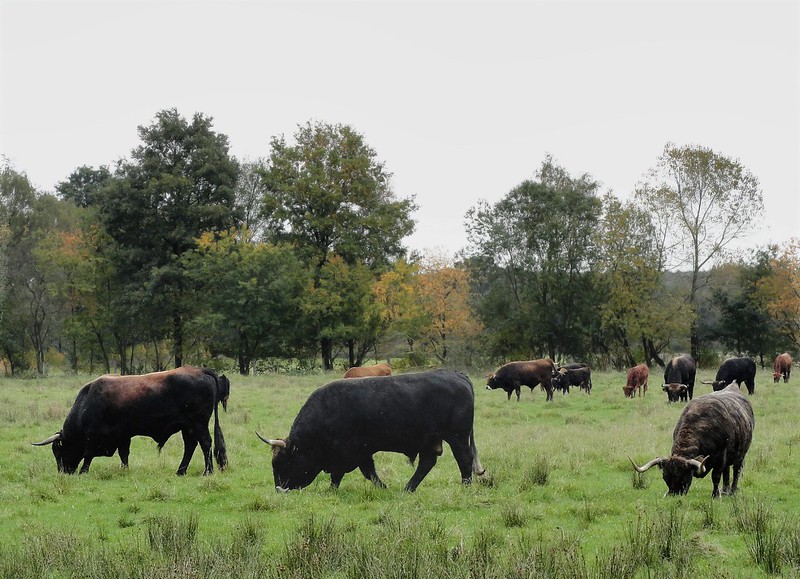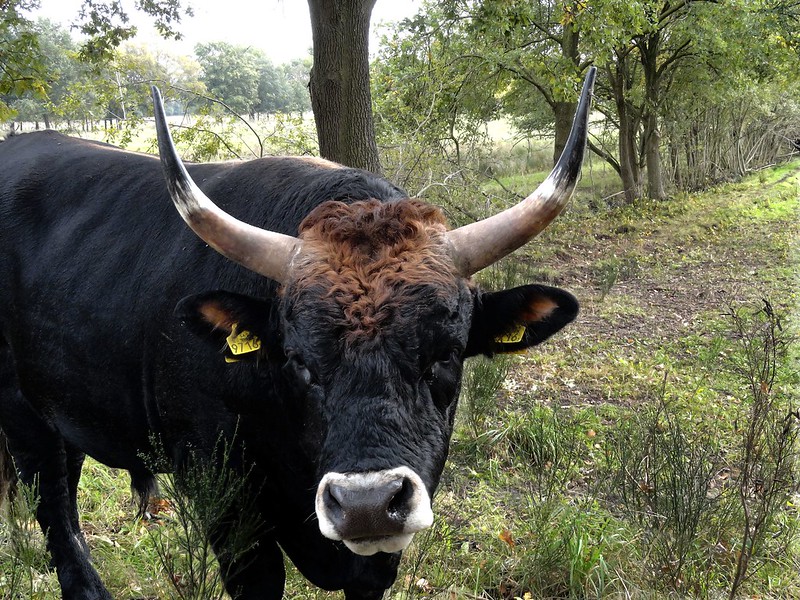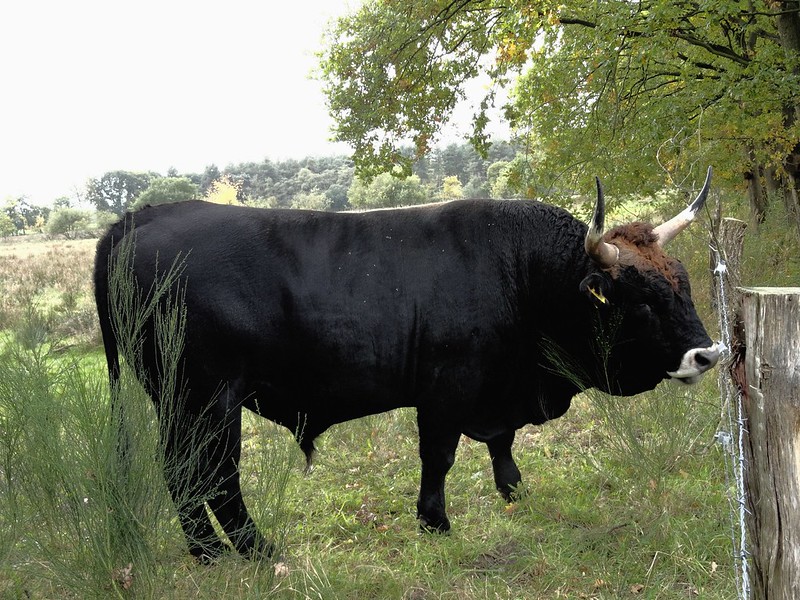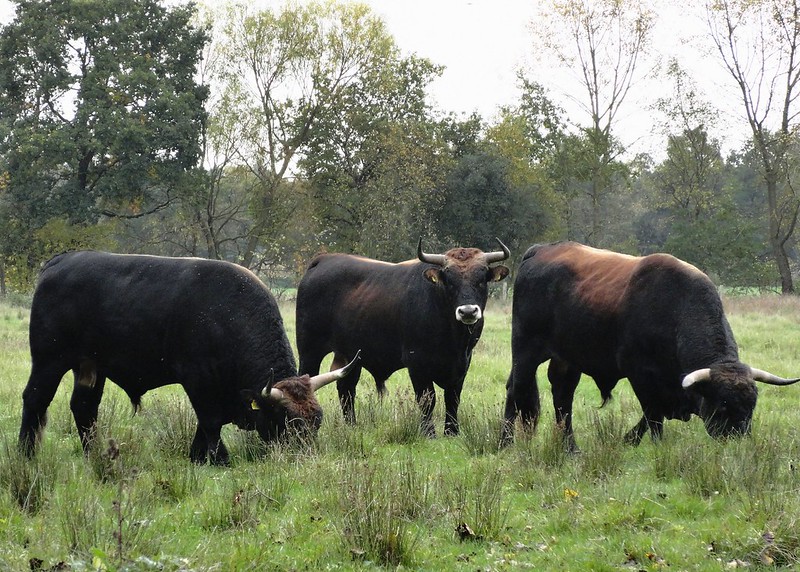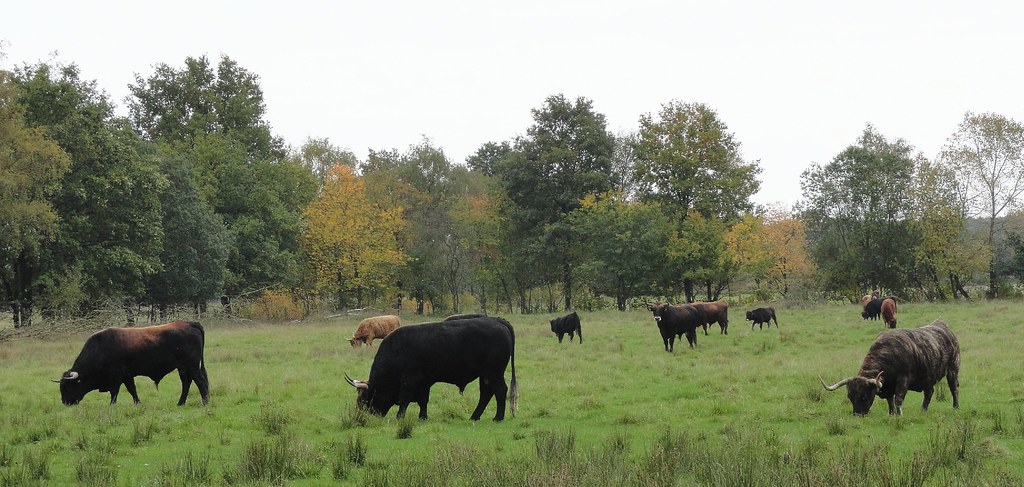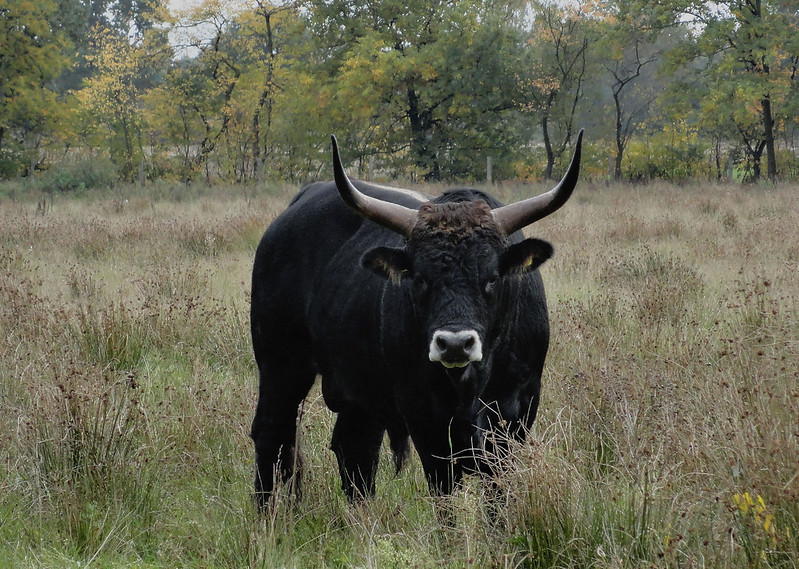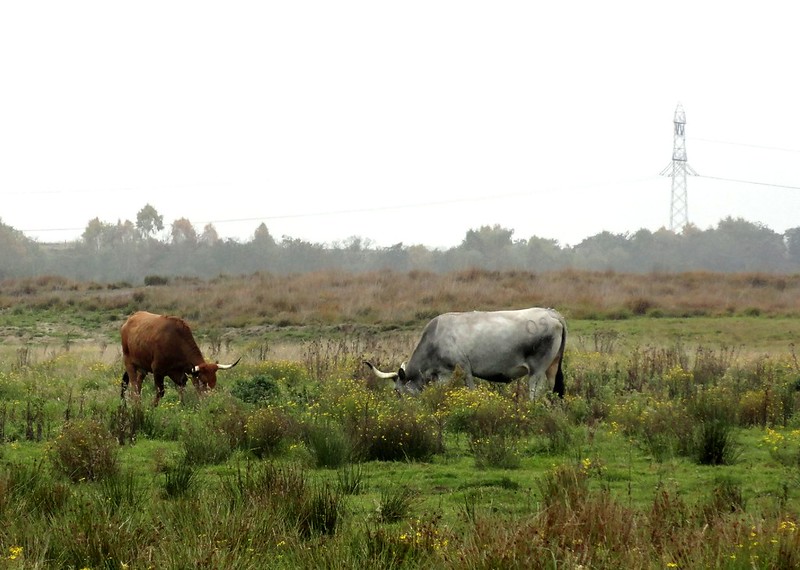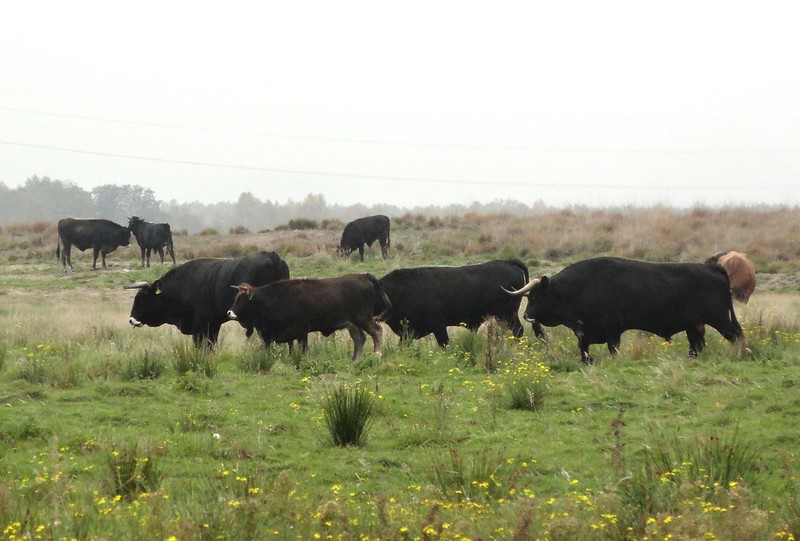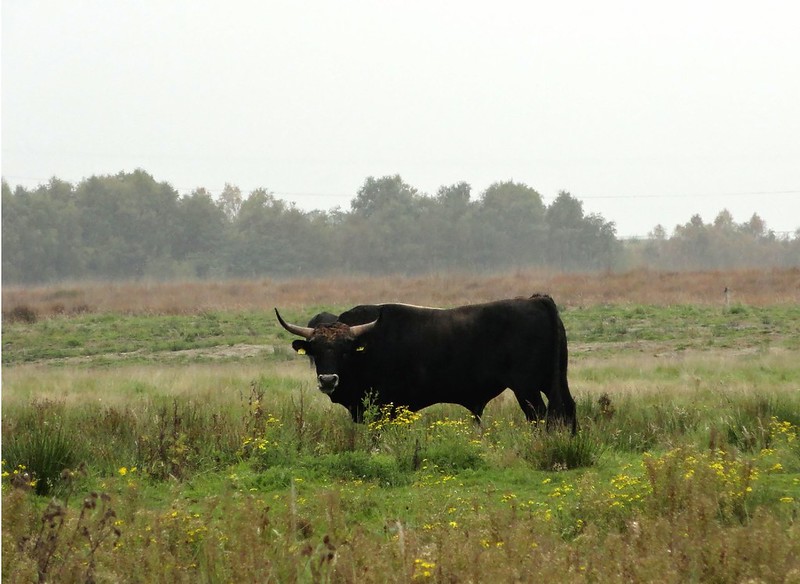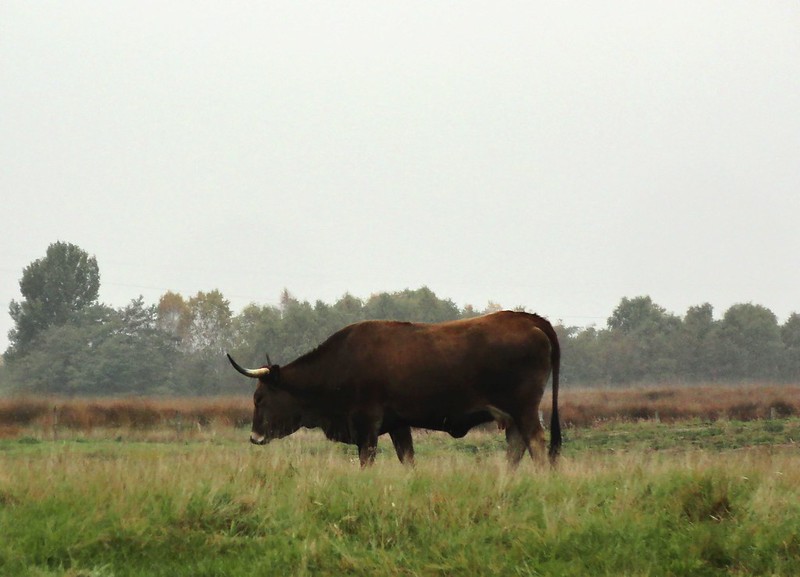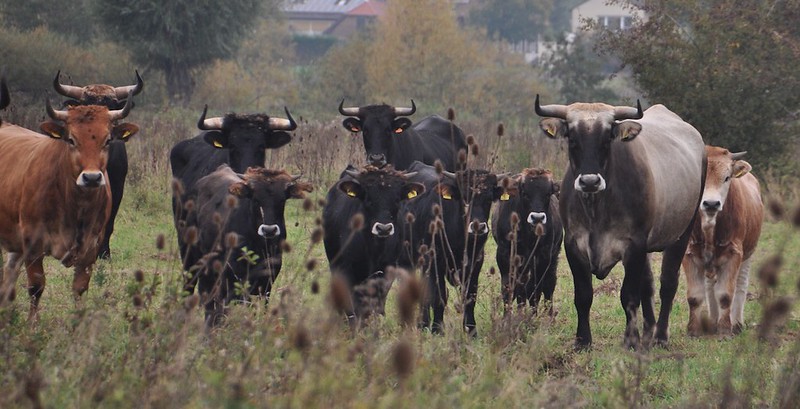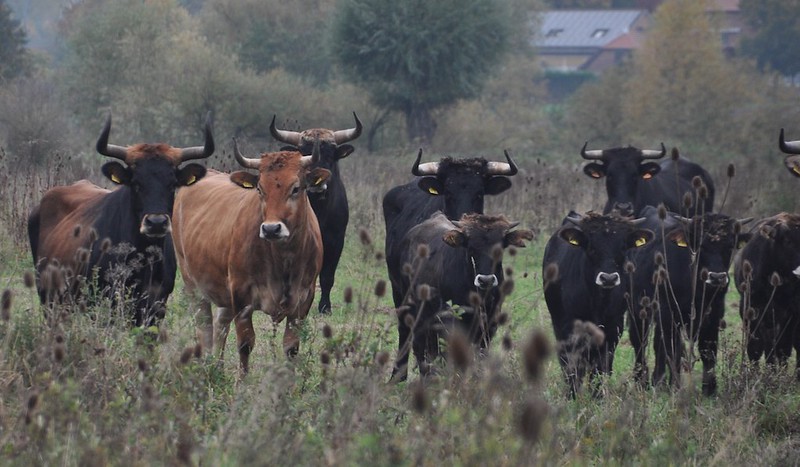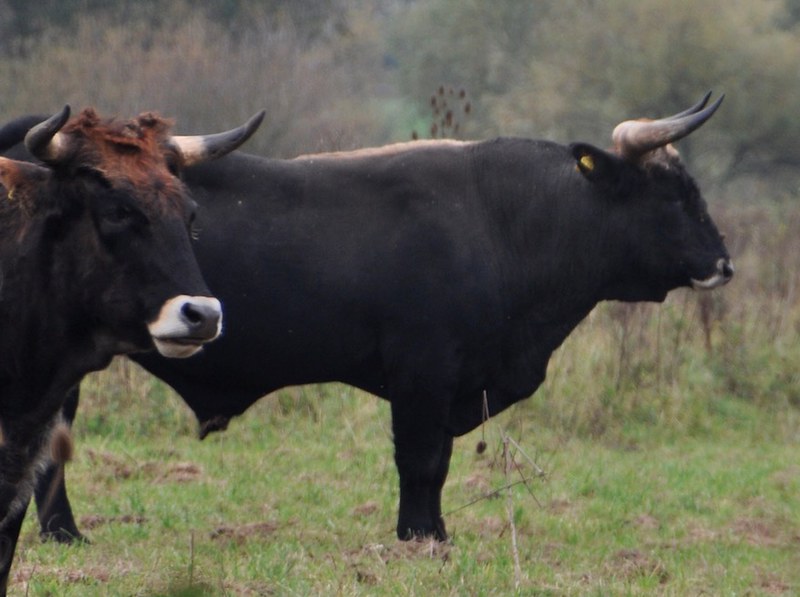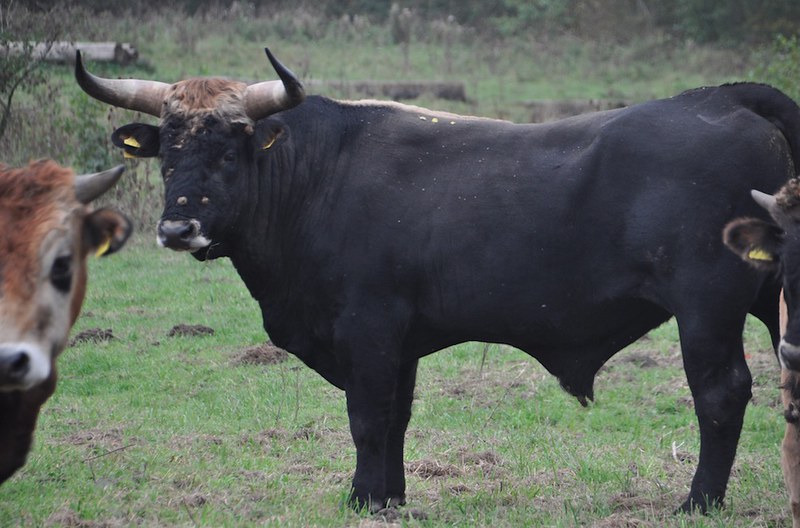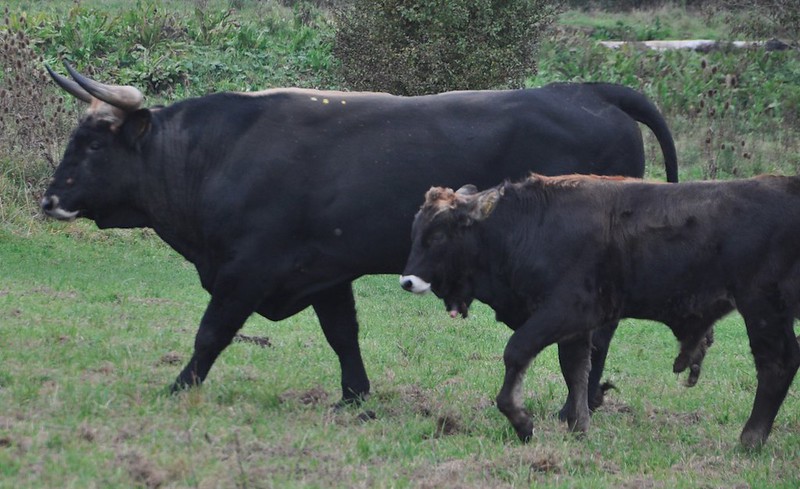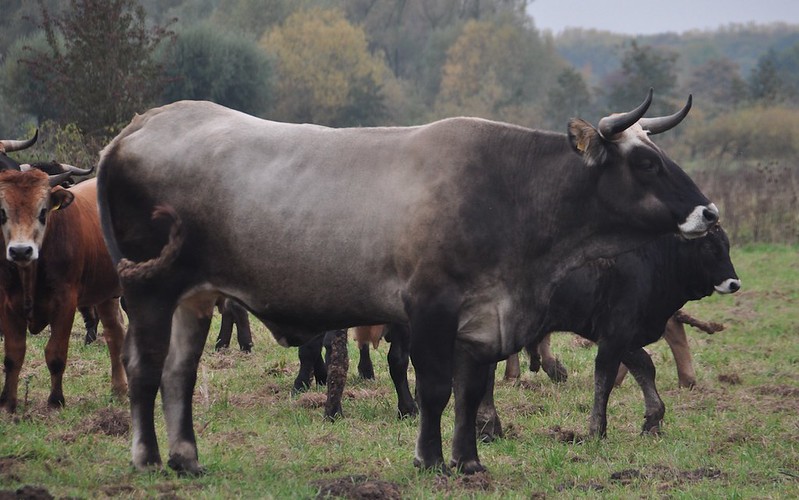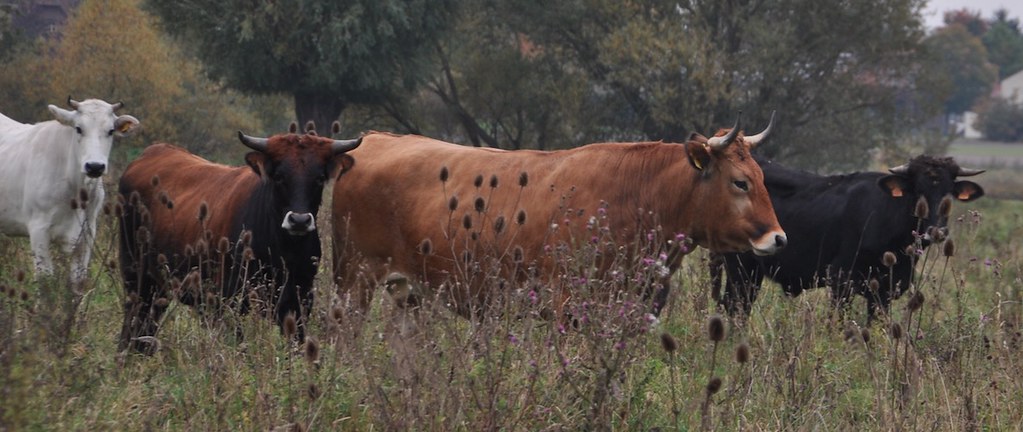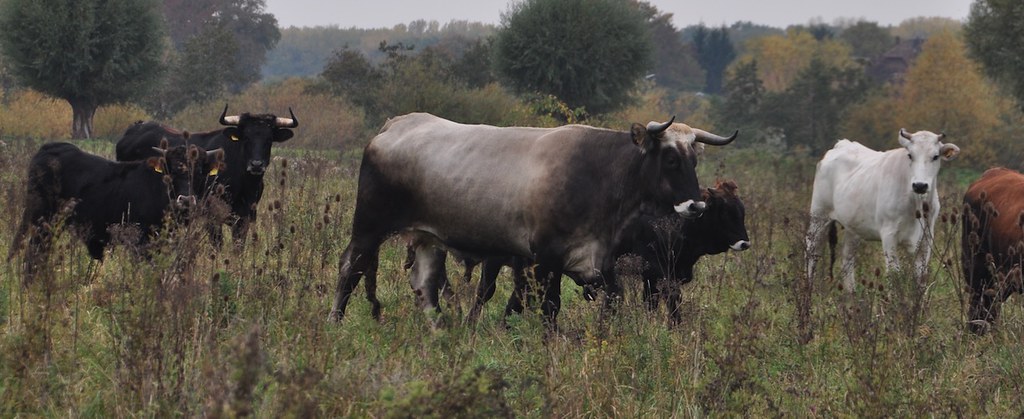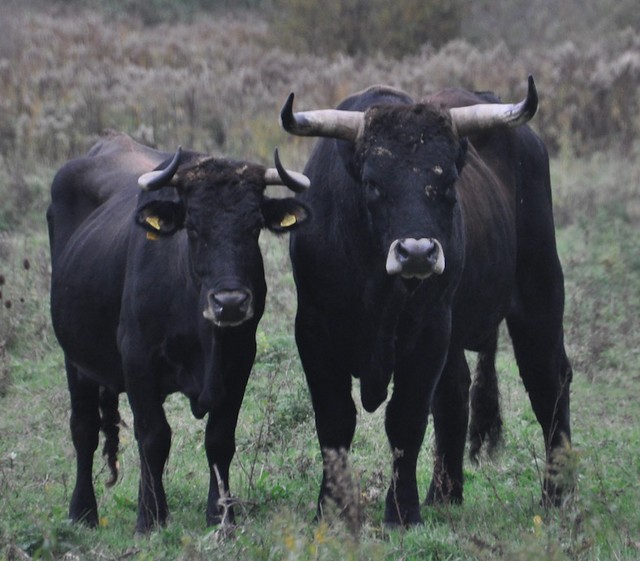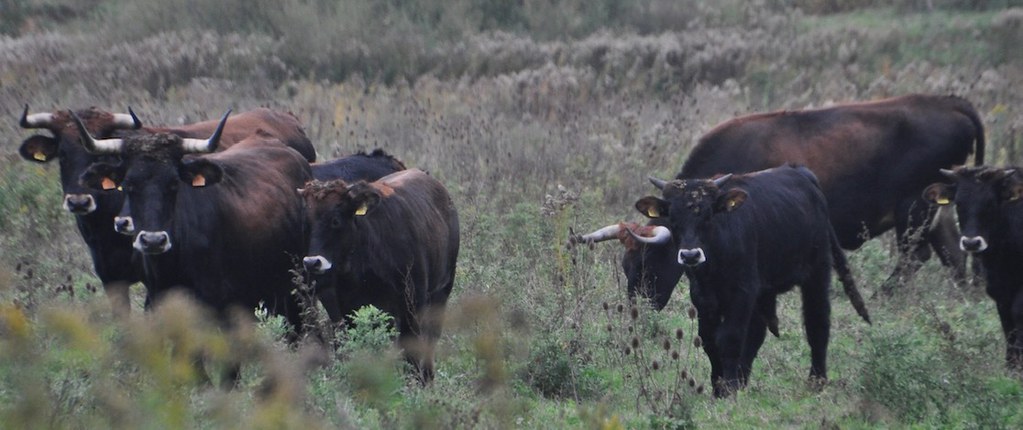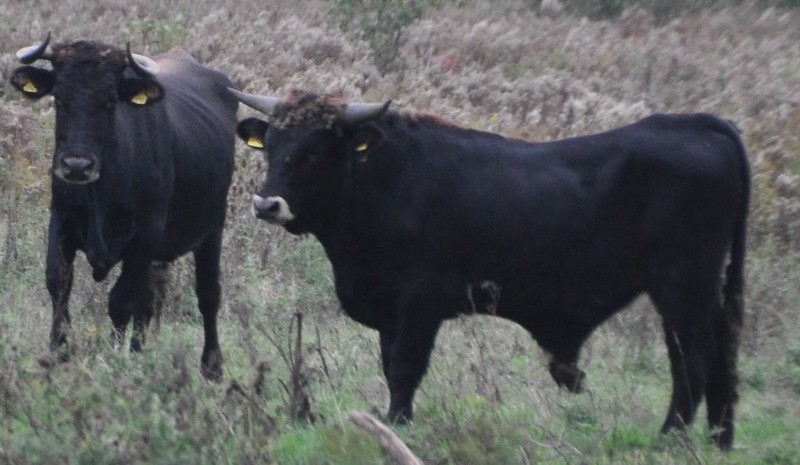Okey, not all that new, but a few weeks old at least. But I haven't had the time yet to post them here because I was busy with my Lippeaue report and university. I only cover the photos here and make no guesses or research on the origin of those animals, because this work has already been done by Roberta on the Carnivora Forum thread.
All of the photos presented here are copyright of Geer vanne Smeed, used with his permission.
Kempen~Broek
The photos here show us mostly bulls, and also the Tudanca x Highland cow that is familiar to us already, plus some young cows that might be Limia or similar-looking crossbreeds. Those He...ah.. Tauros bulls confirm what I guessed back in 2012 already - namely that Highland crosses bred into Southern European breeds will resemble Heck cattle in the early generations. Of course this is no bad thing as such and was to be expected, but Taurus cattle shows us that they will need at least one or two generations more to overcome this heckish bodyshape, and only if they are backcrossed with slender Southern breeds.
Loozerheide
This herd seemingly has pure Maremmana, probably pure Limia as well, some undefinable cross bulls that resemble those at Kempen~Broek and one Maronesa bull (it should be that one but I am not 100% sure).
"Breeding-back" aims to restore or immitate extinct animals by selective breeding. This blog provides general information, the facts behind myths and news from various projects.

Monday, 23 November 2015
Saturday, 21 November 2015
A second trip to the Lippeaue Pt.III: Conclusion
Regarding the
quality of the current population: Overall, the herds are very nice. To better compare the Lippeaue cattle presented on the two previous posts (#1, #2) with the aurochs, here are some of my own artistic interpretations of the wild animal:
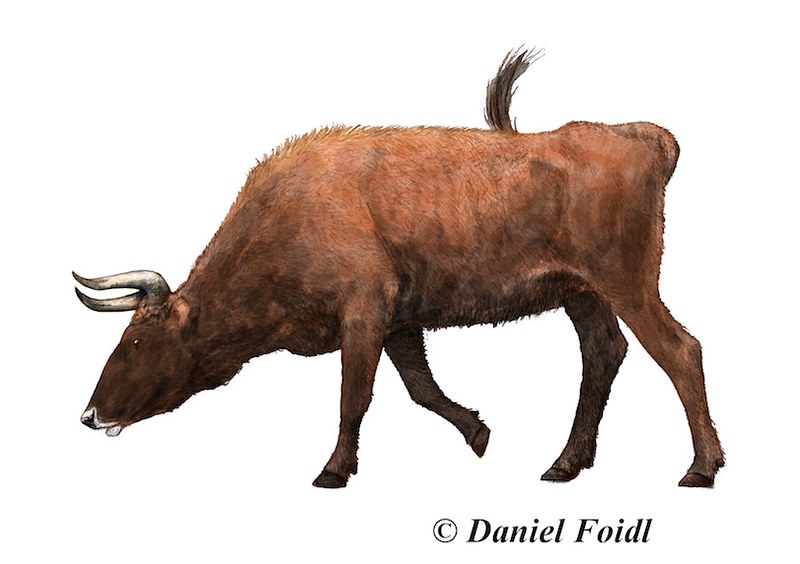 |
| Sassenberg cow - mind that the horns only look that small because they are viewed from the side. They might have been more curved than in my drawing. |
| Bull based on the Braunschweig, Sassenberg and Lund specimen |
The size
of Heck cattle has definitely been surpassed with cows having an average size of
between 150-155 (which is larger than virtually all Heck bulls and 20 cm taller
than Heck cows). I know that three individuals are an insufficient sample size,
but these particular animals neither appeared to be considerably smaller or
larger than the other ones. The fact that the tallest individual in the herd is
a cow and that most bulls are probably between 150-160cm tall does not necessarily imply
that Taurus cattle has little size dimorphism. As I mentioned already, all the large cows have a high portion of Chianina, whereas the breeding bulls are
25% Chianina at maximum or less. If largely Chianina-influenced bulls (such as 01 885)
would be allowed to stay in the herd, I am sure they would surpass the large
cows. Only if the population was allowed to breed naturally, an average mean
for the degree of sexual size dimorphism could be valued. But considering the
genetic diversity of this young breed it would probably be pointless because it
is not genetically fixed anyway.
Many bulls
have a shoulder hump (probably smaller than in aurochs, but that is true for most cattle),
whereas many cows barely have one (another general domestic cattle trait with
few exceptions). Of course Taurus cattle are slenderer and better proportioned
then Heck cattle. Many cows, and also a number of bulls, have the desired
squarely-built trunk with a shoulder height that is as long as the trunk
length. Some bulls, however, violate that rule and also some cows are not as
high-legged as we would like them to be. Regarding the slenderness, a truly
athletic body with a slender waist as in wild bovines is found only in a rare
number of cattle breeds today, such as – not surprisingly – Lidia and
Corriente. And it is not easy to breed for this trait, so it is not a big malus
that average Taurus cattle are not as athletic as the two aforementioned breeds.
For such a body shape to evolve, perhaps there must be intraspecific
competition, what is difficult on small size. But nonetheless, Taurus cattle, especially
some of the cows, are on the better side among the aurochs-like cattle
regarding body shape/proportions – with exceptions.
The skull
shape is variable. Some bulls and cows (f.e. Linnet and 79 842) have a short,
paedomorphic face. Others, however, have a nicely elongated skull just like a
pure Sayaguesa (f.e. 42 604). Most are somewhere in between.
The horn
shape of course is more aurochs-like and forwards-pointing than in Heck cattle.
However, a decent inwards-curve has not been achieved yet, because it is rarely
present in any of the founding breeds (but also a lot of other aurochs-like breeds,
actually). The curvature of Chianina usually is weak, Sayaguesa often have horn
tips winding outwards (with the exception of Dona-Urraca, she produced a lot of
well-horned offspring), Lidia often are not better in this respect and Heck
cattle barely have a useful inwards-curve to begin with. Maronesa is one of the
few breeds that is really good in this respect in many cases, but that breed is
not useful for Taurus cattle: it would reduce the size again, as much as the skull length and
slenderness that has been achieved already (ok, many Maronesa cows are slender,
some may be better than the slenderest Taurus cows in that respect, but many bulls are rather
hefty). Regarding horn size, there is the expected variation. Due to the
Chianina influence, there are individuals that happen to have rather small
horns, others (like Linnet) have a satisfying horn diameter, most animals have
medium-sized horns. I would say that in this respect the average of Taurus
cattle is of medium quality compared to other aurochs-like breeds, with
individual variation. The Wörth cow might bring a certain increase of horn
size. Using a Watussi might be an idea, but the problem is that there are no
Watussi with a useful horn curvature in Germany and importing such from other
countries is too impractical. However, I think stabilizing the maximum horn
size that is present in the population now will be satisfying. By the way, the Taurus
cattle population at Hortobagy, Hungary, has Watussi-influenced individuals, so
let us see how that works out.
Lidia did
not meet the early expectation. It was thought that they would bring
a more athletic body shape while the size would be compensated when choosing
the right crosses, but it did not work out like that. The Lidia crosses were
always small and not necessarily more athletic or better-horned than the other
animals. Furthermore, their behaviour caused a lot of trouble – in bulls as
much as in cows. Most of them, as far as I know, where either slaughtered or
sold (and so was the half-Lidia bull that was sold to Denmark, because of its behaviour).
So working with Lidia was not at all that successful as hoped – Matthias likes to call
the Lidia crossbreeds “small, ugly and mean”.
The colour
of Taurus cattle, being a young cross-breed, is variable as well. Many
individuals, including all bulls that are kept in the herd and probably half of
the cows, do not show an expression of the undesired colour dilution genes
transferred by Chianina and possibly Heck. But considering that these alleles are either
recessive or semi-dominant, they should be widespread in the
population’s genetic make-up. Chianina alone has at least two dilution loci (Agouti and Dun) and perhaps more. But neither I nor the ABU worry all too much
about the colour since it is controlled by only few loci and relatively “easy”
to breed compared to other aspects. And the majority of cows with an un-diluted colour
has the desired colour shades, with varying intensity. There is also variation regarding traits such as light areas on the
inside of the legs or white eye rings (see Lena), for which we have no clue based on
artistic or written evidence, so we cannot say much about that.
Regarding
sexual dimorphism: it is often present, but not always. As I wrote above, the
intensity is varying: there are completely black cows, but also those with a
reddish saddle, or a red/brown part that is that large that only the side of
the belly and legs, neck and head are black, or those that are completely brown
in various shades. I cannot tell how large the portion of black cows is, I can only
guess, perhaps somewhere between 30-50%. Margret and I agree that black cows
can be permitted (there is written and artistic evidence), but should
definitely number below 50%, perhaps around 10% for appropriate colour
dimorphism. Another sign of reduced dimorphism is a colour saddle in bulls. The colour dimorphism of Linnet is as reduced as in a black cow. Therefore I always plea for selecting against bulls with that trait, but the
fact that only one in ten or eight bulls has one makes it less dramatic than it
looks like when a breeding bull has a saddle (I still would not choose such a
bull for breeding, but that’s up the preference of the breeder).
Most, if
not all, cattle on this world have udders that are larger than in the aurochs,
and so do Taurus cattle. I think that regarding udder size they are comparable
to other aurochs-like breeds (they are hairy in all cows as they should be, to
reduce heat loss), and the size varies to a similar extent as in Heck cattle,
with the exception that no Taurus cow has udders that large as those of Hecks
with maximum udder size. The dewlap in both sexes is of medium size as far as I
can tell, and smaller than in many Hecks – I was told that individuals with
large ones might pop out on occasion, but they are the exception rather than
the rule. Chianina has the smallest udders and dewlaps of the founding breeds,
so it might be thanks to that breed.
There is no
reason to think that Taurus cattle do worse during winter than Heck cattle or those
aurochs-like breeds that have been imported from Southern Europe. They do not
have problems in harsh winters, not even pure Chianina that have a shorter
winter coat than the other breeds. The fact that they get supplementary feeding
during winter is because the area is not sufficient to support the whole herd
during winter, especially because it gets partially flooded during that season.
So it is not because Taurus cattle would be “less hardy”, as critics might
claim. Heck cattle calves, and also other breeds like Hungarian Grey, have a
long and dense winter coat that gives them a cute teddy bear-like look during
winter. Sayaguesa and Chianina (and maybe Lidia too, I don’t know) not so much,
but yet I do not know of a Taurus calf that had problems during winter (by the
way, I had the opportunity to stroke a narcotised calf, its coat felt nice,
like that of a cat).
So where
lies the quality of Taurus cattle on the scale of aurochs-likeness compared to
other breeds? I think it is hard to say because it is a heterogeneous
crossbreed yet so they are not directly comparable to primitive breeds that are
more or less stable and therefore always have or lack certain traits.
The
combination of Heck, Chianina and Sayaguesa basically contains all the desired
aurochs traits to a certain extent, but also a bunch of undesired ones you see
in the "not-so-beautiful ones" (if the proportions are not right or the body is
too bulky, small horns or deviant horn shapes, diluted coat colours, large
udders and dewlaps, or short faces) that need to be purged out. Other traits, like
size or sexual dichromatism, have to be taken to a larger extent. As I
described above, many Taurus cattle are very good in sum. Actually, some
individuals are among the most beautiful I have seen so far, f.e. Lamarck,
Lerida, 42 406 and others. But the qualitative difference to other breeds
(those that are not the result of “breeding-back”) always is: heterogeneity
with nearly all desired traits but also many undesired ones vs. homogeneity
with a lack of certain desired traits but also the presence of (fewer)
undesired ones.
The animals
in a herd that is artificially selected usually are not representative for the
gene pool of the population/breed because the “bad ones” are taken from the
herd. Consequently a herd always looks better than its genotype is. And the
less individuals there are, the less representative they are. For example, the
approximately twenty animals in the former Heck herd on Wörth are certainly not
enough to say much.
So a large
(more than hundred), freely-reproducing herd of Taurus cattle, would give us an
idea of their actual gene pool and potential. All possible combinations of the
traits of the founding breeds would show up, including some really nice and qualitative
individuals, but also “ugly” or even strange-looking ones (f.e. see
Oostvaardersplassen), and most would be somewhere in between. It would be highly
interesting.
Friday, 20 November 2015
A second trip to the Lippeaue Pt.II: The herds #2
The previous post covered three of the two current herds in the Lippeaue from my 2015 trip. This post is on the remaining two, Klostermersch-Südseite and Hellinghauser Mersch.
(I claim copyright for my photos, please do not use without permission)
(I claim copyright for my photos, please do not use without permission)
Klostermersch-Südseite
In 2013, I
hoped that this son of Lamarck would become a breeding bull, since he looked
quite promising to me. Well, he is now, and his name is Londo. He looks a lot
like his father, his horns are even a bit thicker. His deficiency compared to
Lamarck are his shorter legs and the longer trunk, and he is comparably small. But he
is a “true F2” because both his parents were of the same cross combination (his mother 84 024 is a fullblood sister of his father), and
so he should be more genetically stable (Lamarck should actually be not stable
at all). Might this be more important than his undesirable traits? I think we cannot
know. But he will be used until a better bull will be available. Maybe the bull
calf he produced with Larissa will be better. Larissa is the largest animal in
the whole Lippeaue, also larger than the bulls. Larissa is half Chianina and
half Lombriz (Sayaguesa x (Heck x Chianina)), therefore about 62% Chianina. Larissa
has a three years old daughter, 79 824, whose father was Churro. She is called
Lena now, on my suggestion (the name of my deceased Golden retriever).
Her colour is interesting. Lerida, one of the oldest cows, is still present.
She is a Heck x Sayaguesa and has always been one of my favourite cows of the
early Taurus cattle. Together with Churro, Lerida gave birth to a beautiful cow
(79 846) that looks good despite her wholly black colour. I also like Laniana
because of her authentic colour, although the horns are not that good. She is a
daughter of Lombriz and one eighth Lidia. In this herd, there are two new
Sayaguesa cows. One has nicely curved horns, the other one rather-Chianina like
ones, but both are long-snouted.
Lale is
daughter of Lucio and Ludovica, therefore (Heck x Sayaguesa) x (Heck x
Chianina). Except for some traits in the head and her larger size, she could
almost be mistaken for a normal Heck cow, but gave rise to nice offspring (f.e.
here, not present in the herd anymore).
Speaking of
size, we managed to measure two cows in this herd as well: Liberta, and a Chianina (Larissa’s mother). Both were
measured with about 153cm at the shoulders, but considering that they were
feeding at the moment they might be one or two centimetres larger. Considering
that Bionade is the same size, and that Larissa, being the larges individual in the Lippeaue, is larger than all three, Larissa might be 160cm tall at the
shoulders. That, of course, means that all the current bulls are below this
mark. Liberta is a daughter of Lombritz plus a (Sayaguesa x Heck) x (Sayaguesa x Heck) cow Lissy, so a total mix.
One
explanation for that might be that all the breeding bulls chosen have and had
not that much Chianina in their ancestry (25% or below, with the exception of Luca). So my hope for big bulls (for bulls,
only a size of at least 160cm is ok for me, and everything above satisfying) are those with much
Chianina. There is one young bull that is the same combination as Larissa (but
with Laokoon as father instead of Lombriz) that made a good impression to me
(01 885). Slightly more than a year old, and was walking with grace on long legs when I saw him.
The body looks tight and the back is well-shaped. Being half-Chianina, the
colour is diluted and the horns do not look as if they are going to grow large.
But I plead for giving that bull a chance to see how he works out. Of course, a
lightly coloured bull is considered unsatisfying, but colour is regulated by
only few loci so it will change easy, the genes for those dilutions must be
widely distributed in the population anyway, and a lot of diluted cows are
permitted in the Lippeaue. So I, personally, would use a bull with that colour
if he is large and well-shaped. Whether a bull is going to grow large or not is
not easy to say by that age. I was told that one indicator for how large cattle
grow are leg proportions at young age. If a young bull has rather long legs
like on stilts, it might grow large (allometrically, this makes sense). There
was a second half-Chianina bull as well, a son of Londo, but that one did not
work out well, it is going to be removed.
By the way,
there was another cow with a dark mouth, again with no Lidia but nearly evenly
distributed portions of the three other breeds. Since it never appears (as far
as I know) in Sayaguesa, and is that rare in Heck cattle that it would be a
pretty large coincidence if it shows up in these crossbreeds, I think Chianina
might be responsible for that trait, masked by the dilution factors as
speculated above.
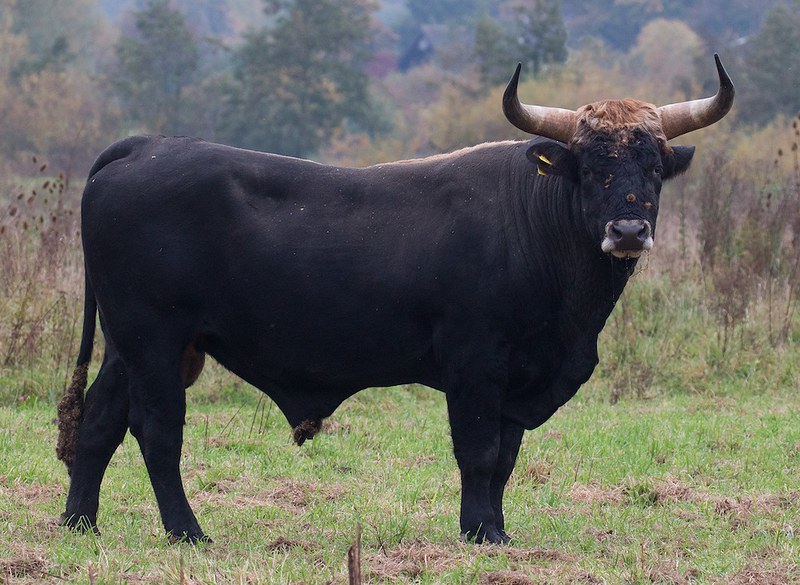 |
| Londo, son of Lamarck (photo © Margret Bunzel-Drüke) |
 |
| Londo with a cow that is nonidentifiable to me |
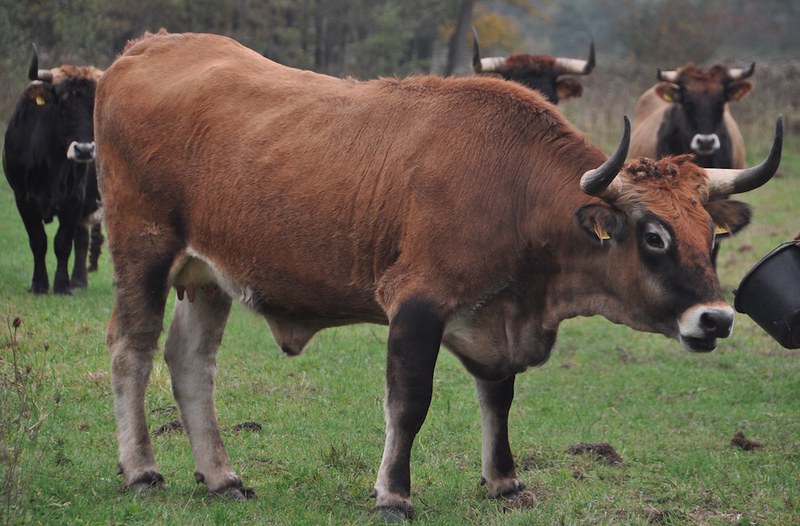 |
| Lena, Larissa's half-Sayaguesa daughter |
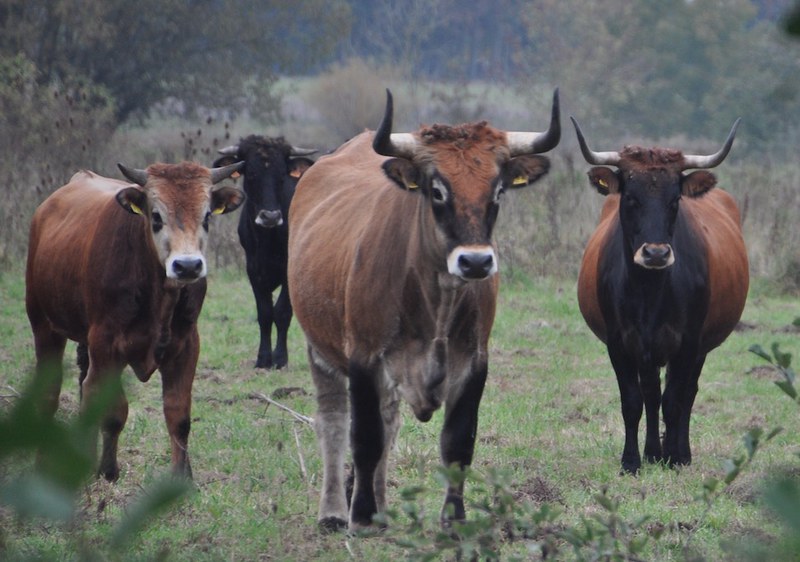 |
| 01 885, a Sayaguesa, Lena, Laniana |
 |
| Laura, pure Chianina and mother of Larissa and Lombriz |
 |
| 55 392, Londo x Chianina |
 |
| Lale, (Heck x Sayaguesa) x (Heck x Chianina) |
 |
| Liberta, more than 153cm tall. |
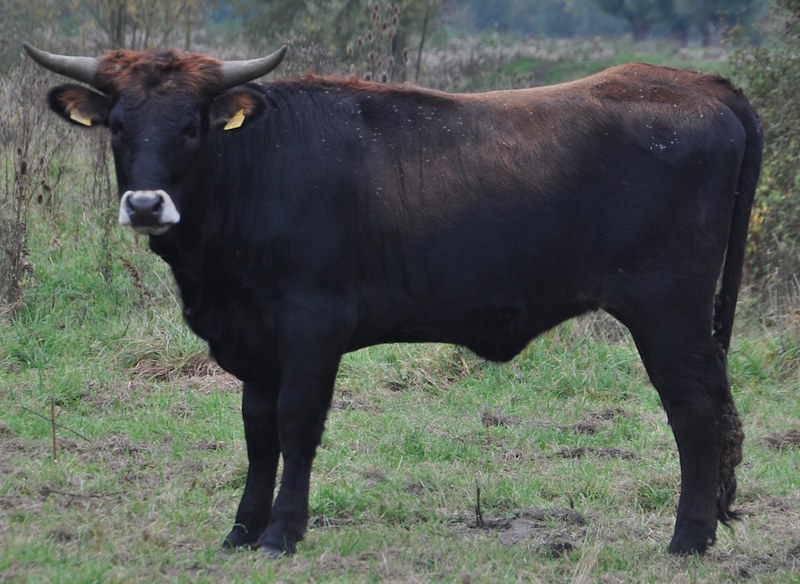 |
| Young cow, non identifiable to me |
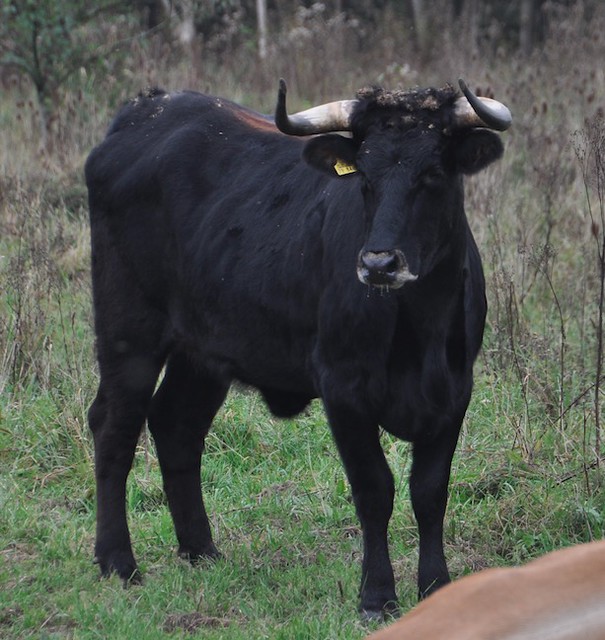 |
| 79 846, one quarter Heck, three quarter Sayaguesa (Lerida + Churro) |
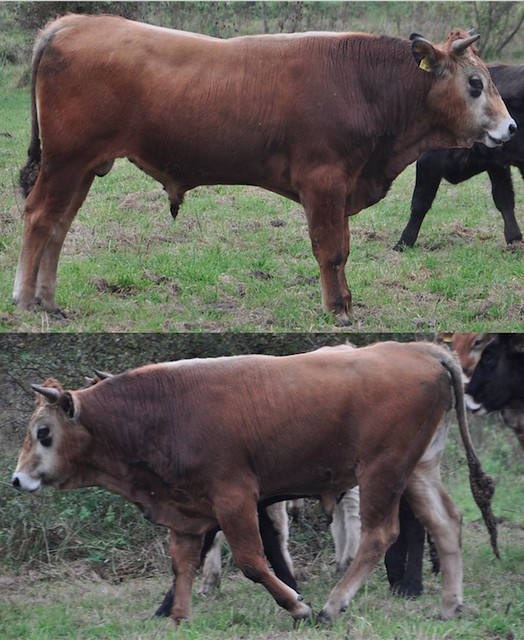 |
| 01 885, half Chianina. |
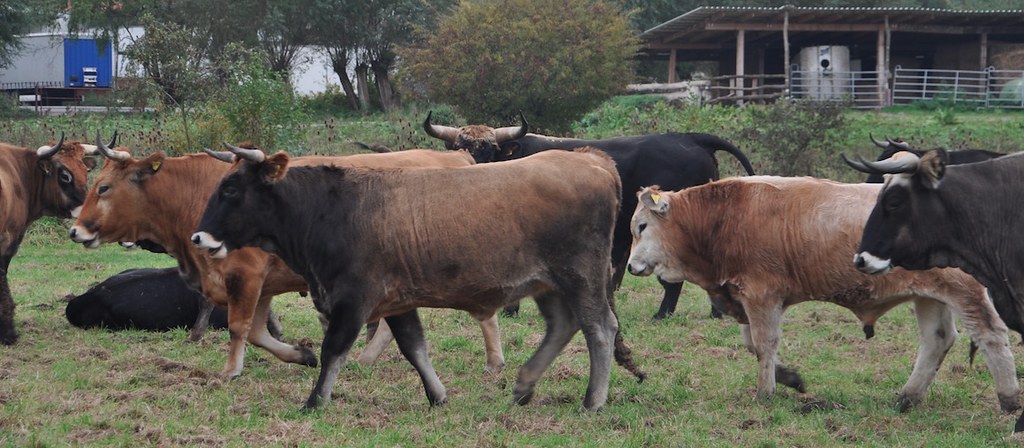 |
| Cow in the foreground is a daughter of Laokoon and Liberta |
Hellinghauser
Mersch
This herd
is the largest (it is actually that large that they have to remove some more
animals this year). The new breeding bull there is 42 623, simply called “Laokoons
brother”, moved from Klostermersch-Süd (where he was in 2013) to Hellinghauser
Mersch early this year (video). All in all, it is a nice bull despite its a bit
massive body and the colour saddle. The face is not that long and its horns
should have a stronger inwards-curve, but he has a prominent shoulder hump and it
turned out he grew quite big. He is four and a half years old now. Dona Urraca
looks small compared to him, although she is actually a large cow (in 2013, I
was standing directly beside her. But I will not guess what size she is and
therefore not about 42 623 either). With an age of 19 years, D. Urraca is the
oldest individual in the Lippeaue today and still calving. Most of the animals
with good, inwards-curving horns descend from her. There are two cows in this
herd I like the most: 42 604 and 79 289. Both are fullblood sisters (parents
are Lamarck and Julia, the red Sayaguesa), look good and astonishingly similar.
I saw the former as a 2 year old in 2013 and thought she was very promising,
and she turned into a really nice animal (and has born three calfs by now). Just look at how the horn shape changed. Another
nice cow is 79 813, daughter of Lamarck and Lepisma, the Luca x Lidia cow. Horns
and stature of that young cow are good. She is a cautious one, but I hope she
will be kept in the herd. Lepisma has a young bull to date, that has Lamarck as
father. It will not be kept, which is understandable: greyish saddle, longish
body at this age already, and a somewhat compressed face. Loren, the large
greyish one, is mostly Heck and Chianina with only few Sayaguesa in her. She
did not impress me at all when I saw her in 2013, and when I saw that she is
still in the herd earlier this year I was surprised. But I was told that she is
a stabilizing element in the social structure of the herd, a kind of alpha cow.
However, she has a greyish daughter with meagre horns that will be removed. Loren’s mother is
Lirgit. Lirgit herself is a daughter of Luca and Lola, which was a daughter of
the Dutch Heck bull Mator and a Heck x Sayaguesa cow. Yes, they also used a
bull from Slikken van Flakee for some time some years ago and therefore not
exclusively Neandertal Hecks. Some more cows need to be removed from the herd, I suggested to remove Laola ( Sayaguesa x (Heck x
Chianina) ) because of the massive Heck-like body with the large udder (her
head and horns somehow remind me of Maronesa), but they want to keep her,
probably because of her good colour. An interesting example for how a cow might
gain weight with time is 84 028, mother of Londo. Compare the photos from 2013
and 2015. 42 617 is going to be removed (too nervous), looking at her aspect it
is perhaps not that much of a loss.
The herd
has three Sayaguesa cows. The red one, Julia, was mentioned already. Another
one has a reddish saddle but outwards-facing horn tips. The third cow also has
this horn shape, is completely black but has a good skull shape. By the way, the
red colour of Julia is because she is from a herd with influence from Alistana-Sanabresa.
The Sayaguesa in the Lippeaue and in the Tauros Project are from the same herds
(except the old ones).
Hellinghauser
Mersch also has a number of young bulls with an age of at least one and two
years. They have to remove some of them, and we discussed which one should be
chosen to be shot the next day. It was not easy because the quality is hard to
guess at that age, especially regarding horns and body shape. All of them had a
flawless colour, and I am focusing a lot on body shape (see the bull I
described as my favourite). I suggested to take the bull with the blond
forelocks, which had the bulkiest trunk and the least promising horns. It was
shot the next day. The bull I called my favourite looks good now, but mind that
its trunk will become heavier and longer. I cannot say what the horns might going
to be like, but it has a good hump already.
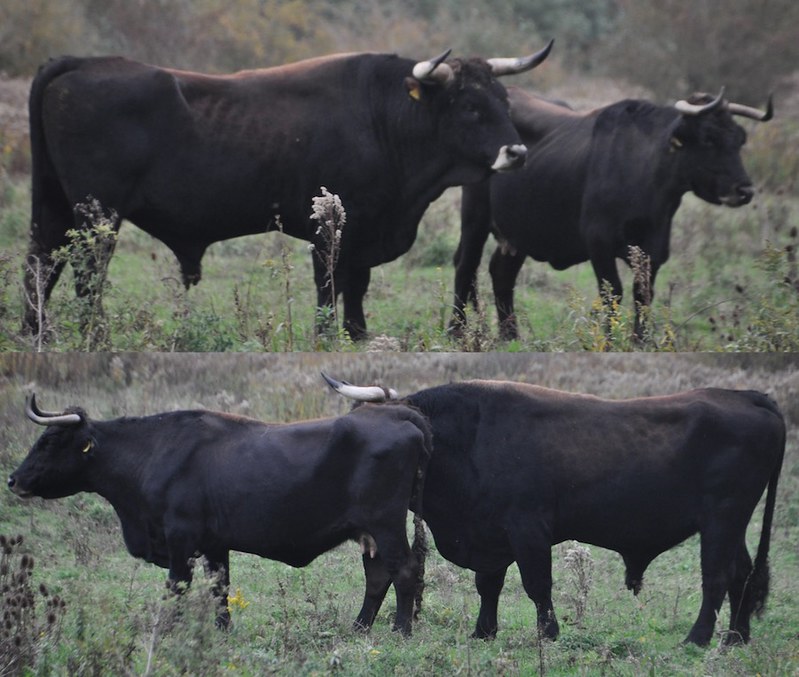 |
| "Laokoon's brother" and Dona-Urraca. Notice the size difference. |
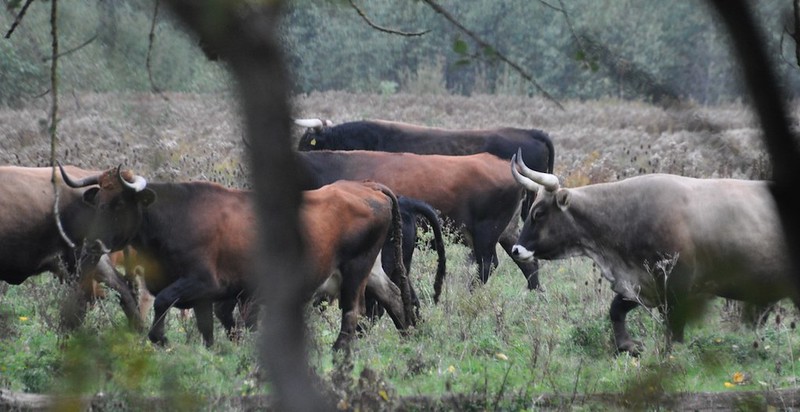 |
| Julia, the red Sayaguesa, on the left side in the foreground |
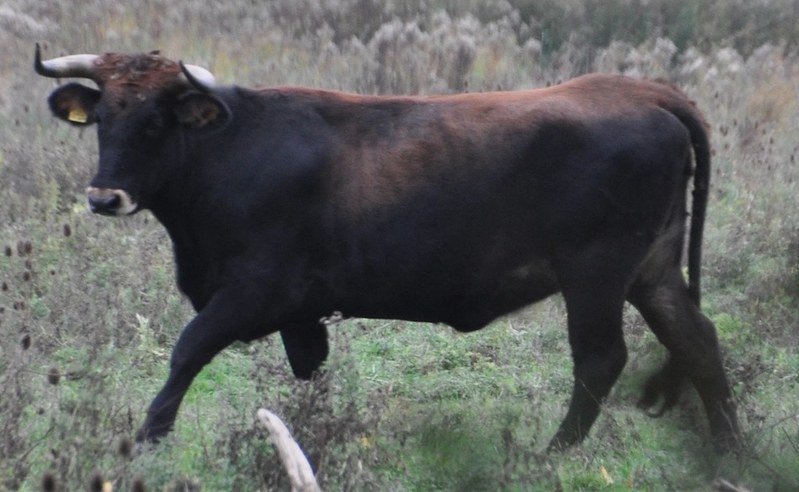 |
| 79 289 |
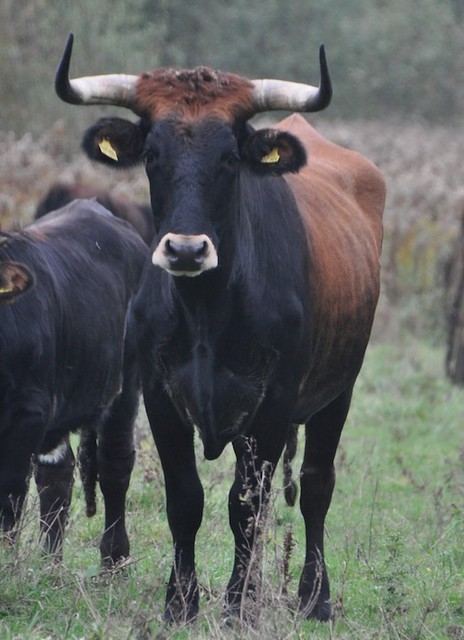 |
| 42 604 |
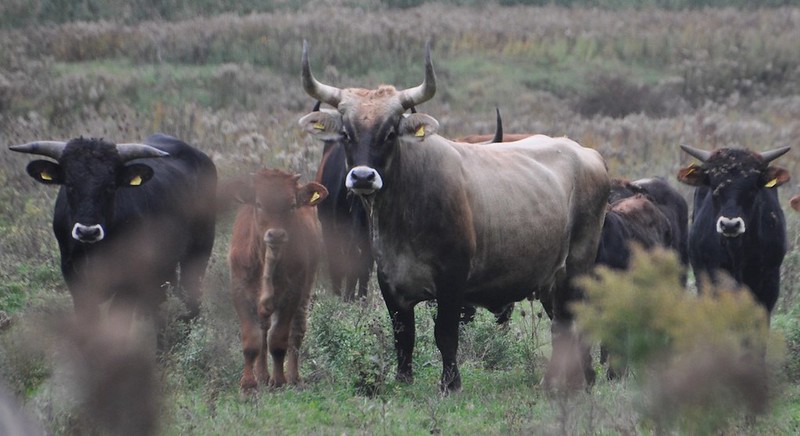 |
| Loren (middle) |
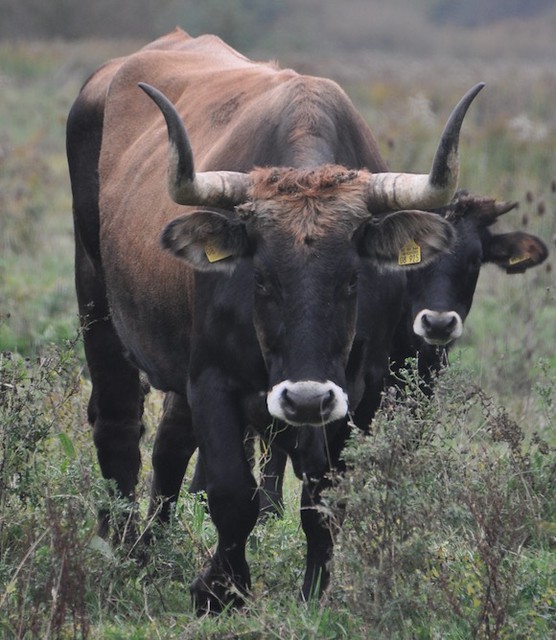 |
| Lirgit |
 |
| 79 813, quarter Lidia, daughter of Lamarck |
 |
| Young cow, 42 289, and 42 617 |
 |
| Laola, Sayaguesa x (Heck x Chianina) |
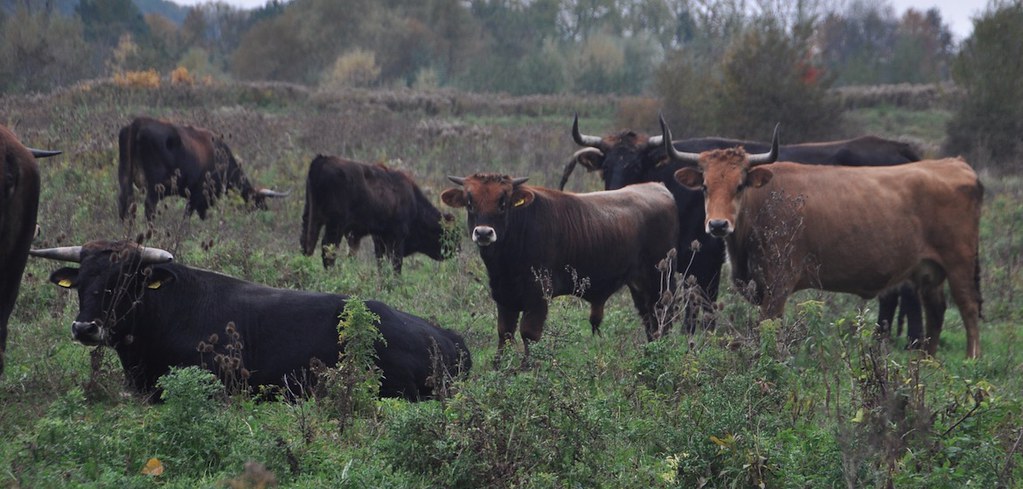 |
| Lepisma and her quarter Lidia bull calf |
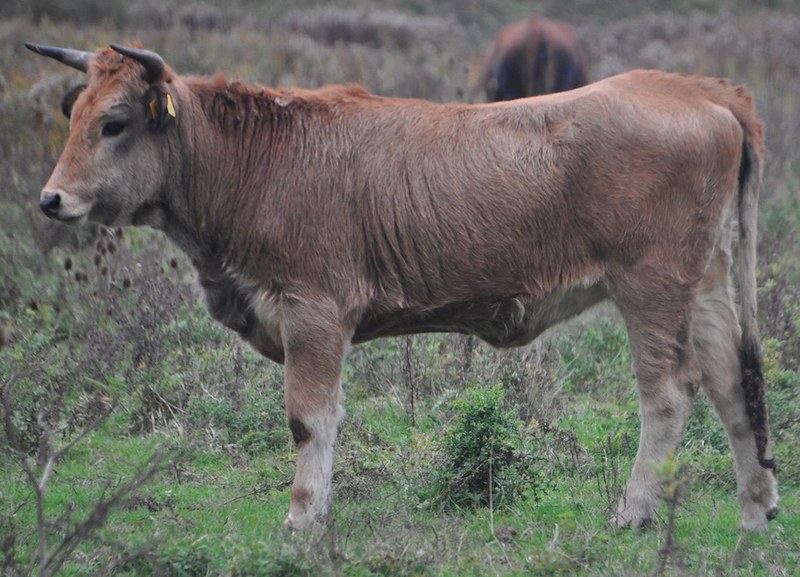 |
| Daugther of Lamarck and 604 |
 |
| 42 604 |
 |
| 84 028, Londo's mother today |
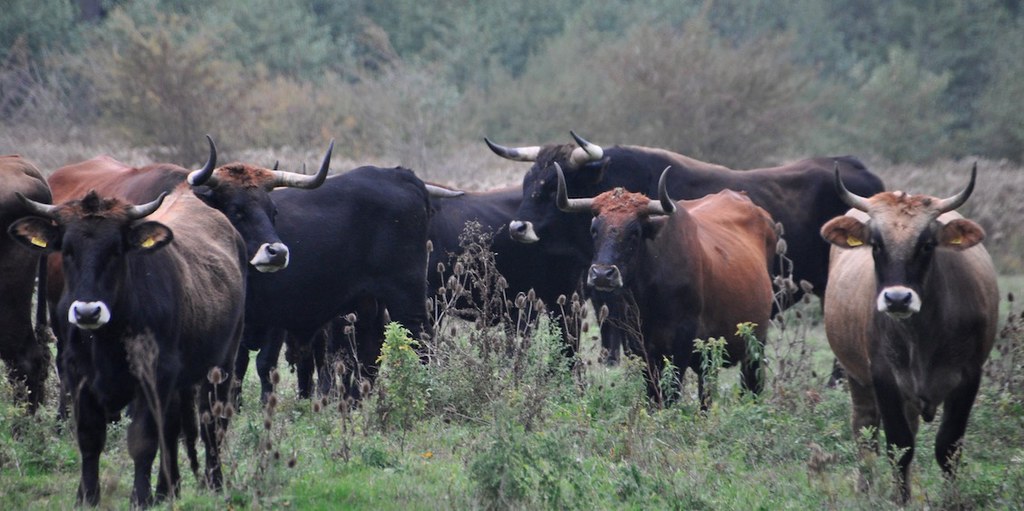 |
| Loren's daughter that will be removed at far right; Julia in front of 623 |
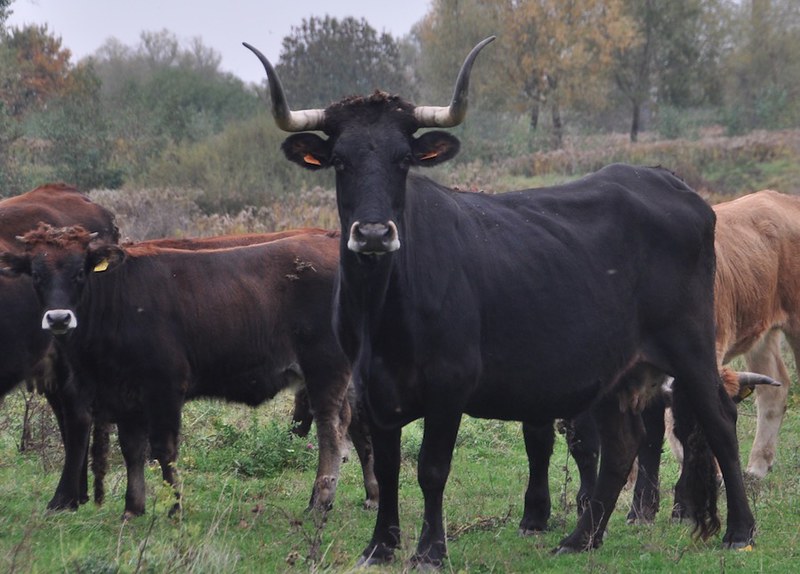 |
| One of the Sayaguesa cows from the Netherlands |
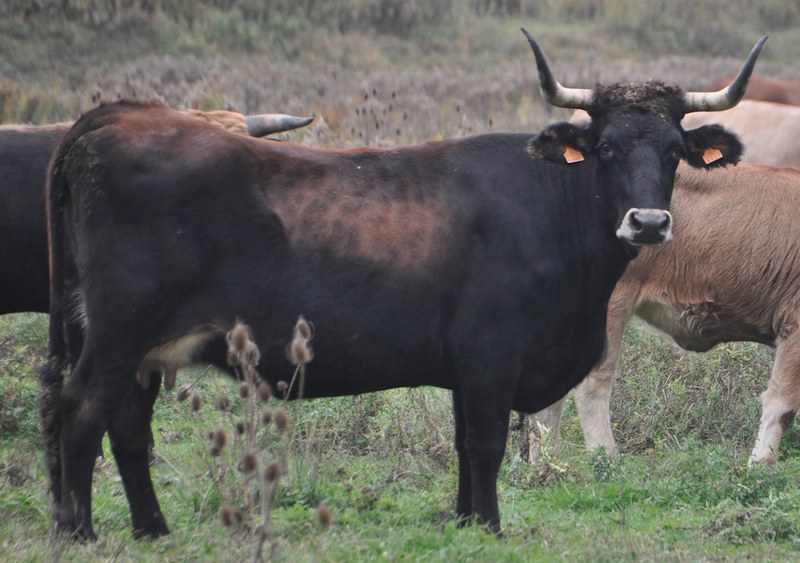 |
| A "saddled" Sayaguesa |
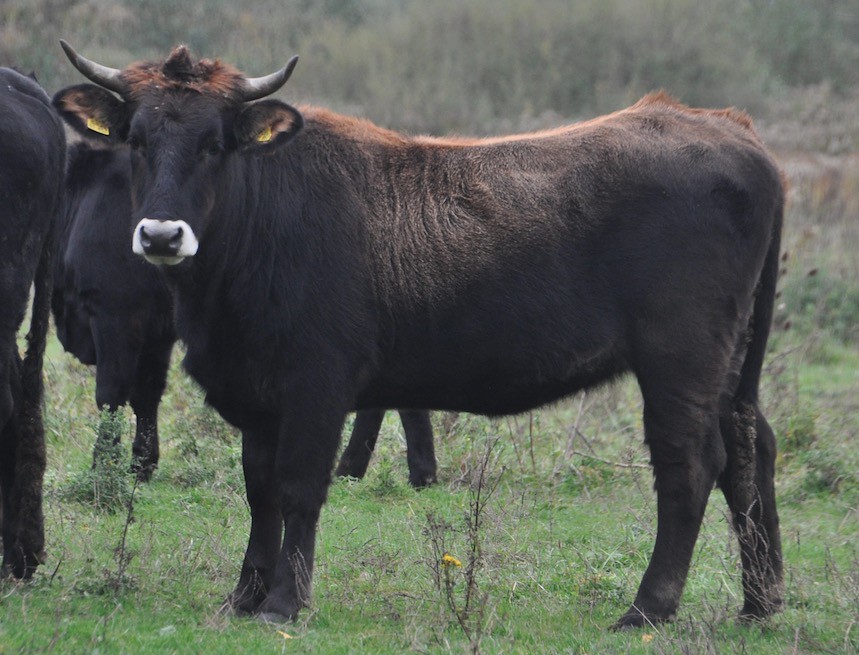 |
| Young cow, I don't know the identity |
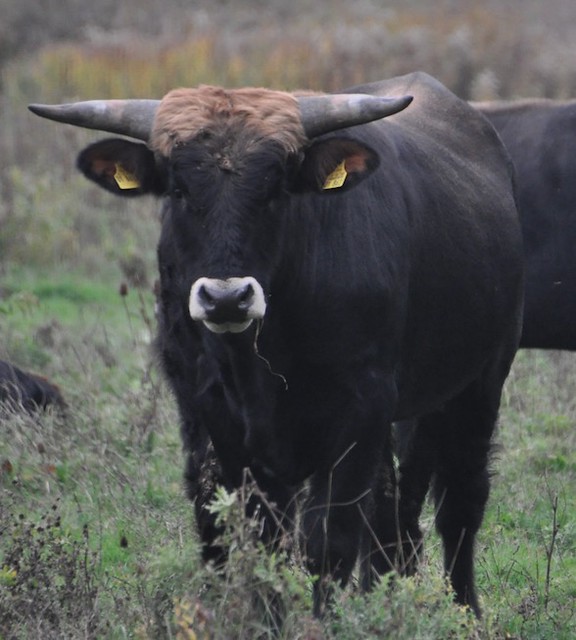 |
| The "blond" bull that was chosen to be selected out (father Lamarck, mother Lepisma) |
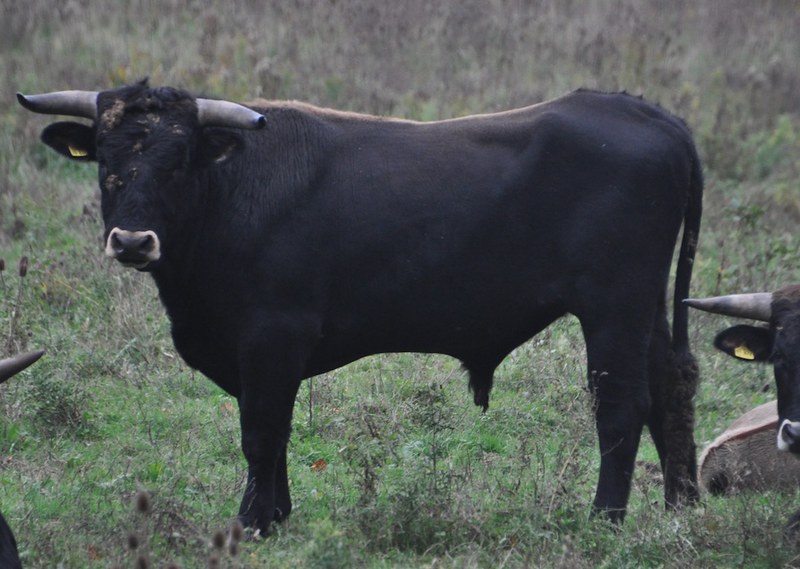 |
| My "favourite" young bull at H. Mersch, father Lamarck, mother Julia |
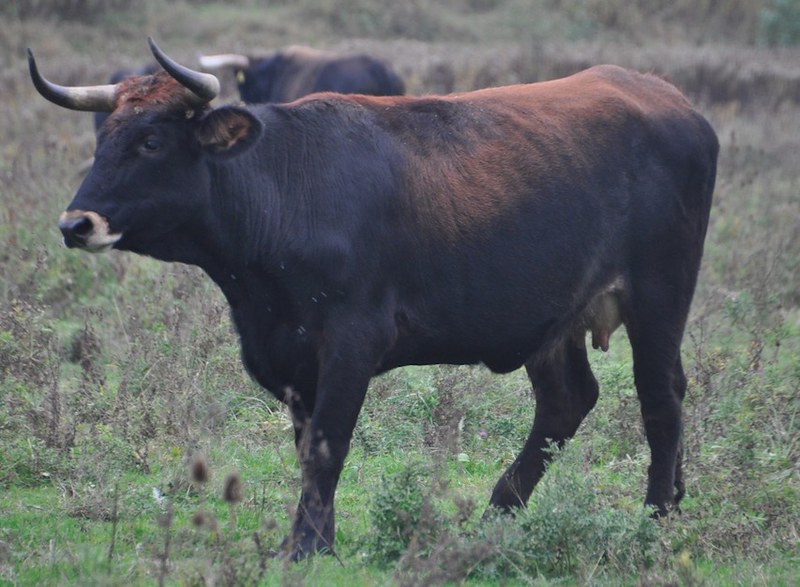 |
| Don't know the identity |
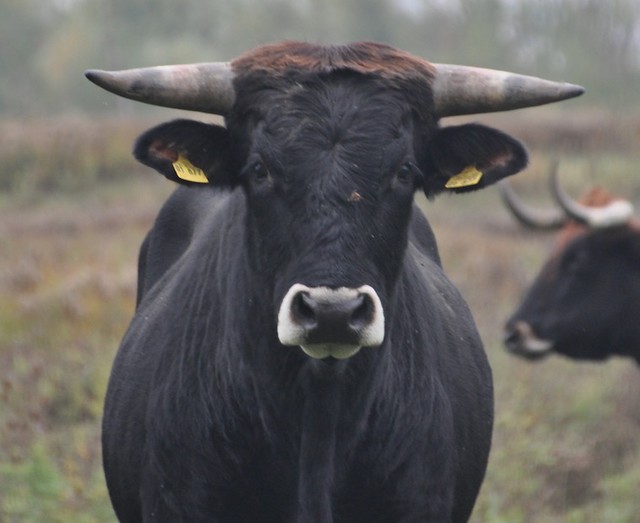 |
| Another young bull |
One of the
young bulls in the herd has a large white spot on its belly. Spots are
seemingly passed on by cows only, and spotted individuals always have at least
one spotted parent. So they are not sure if they should keep a good cow with
spots or not (one example was 92 580, she was removed because of her white
spots despite being quite good). In general there are several types of white spots (excluding colour-sided and roan-pattern now): those
on the belly, “socks” on the hind legs and an elongated spot in the middle
of the face. Only those on the belly occur in the Lippeaue. All four breeds might
have brought that trait into the population.
For the next post, go here.
Subscribe to:
Posts (Atom)
